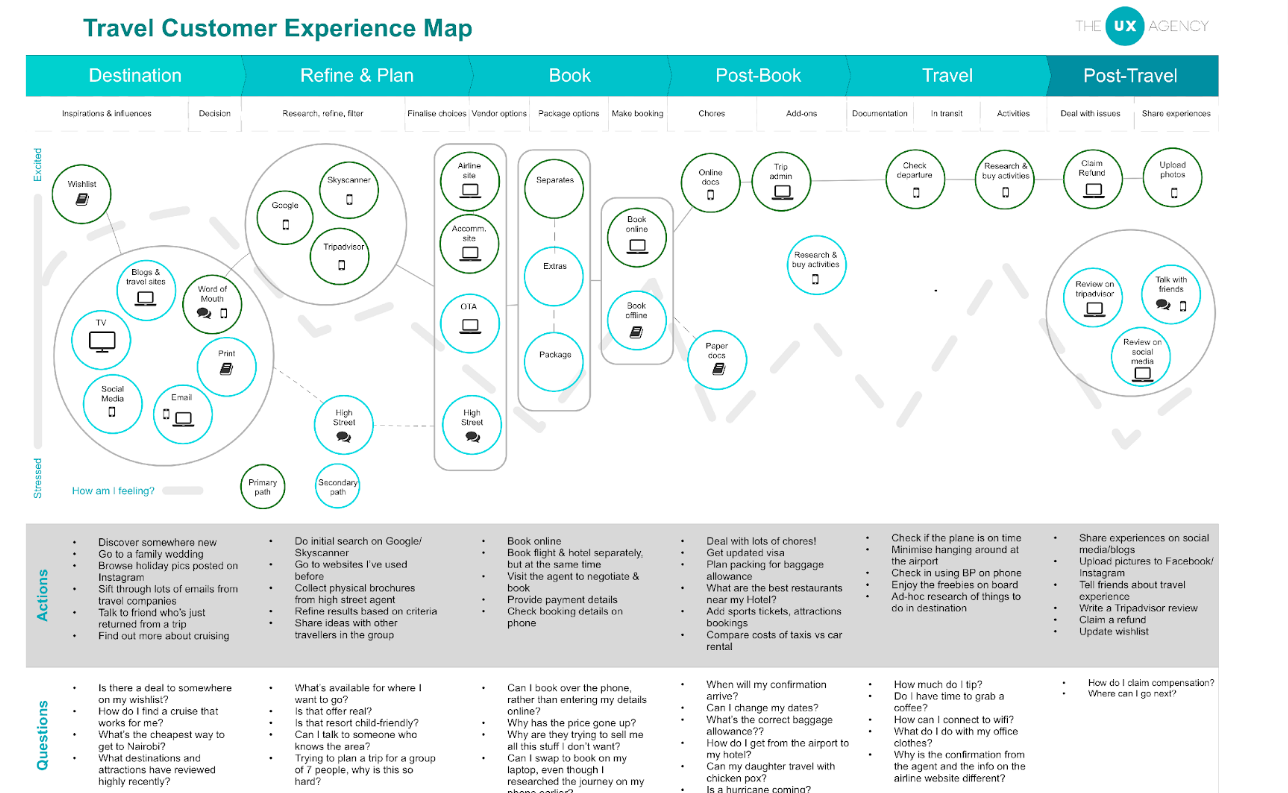Customer Journey mapping seems to be a buzzword in the UX and CX space. But before jumping on the journey mapping bandwagon, it’s important to understand how much value they could bring to your organisation, how to use them, and perhaps most misunderstood - how they’re born out of fieldwork, not guesswork.
What is a customer journey map?
In short, a Customer Journey map illustrates your customer’s experience and journey throughout their relationship with you - from awareness of your product or brand to their potential advocacy of it.
At first glance, a customer’s journey appears fairly simple. However, journey maps demonstrate that customers often have multiple touchpoints and can oftentimes have a disjointed experience.
From a customer’s perspective, they want their experience with you to be seamless. Ideally, every touchpoint should benefit or delight a customer. Referrals, multi-channel advertising, search, social media, customer service enquiries and much more can be considered touchpoints and each and everyone of these should be considered an opportunity to add value to the customer's journey.

The benefits of Customer Journey Maps
Customer journey mapping helps you spend time in your customer’s shoes so that you can see things from their perspective. A good customer journey map should help you build a body of insight; allowing you to quickly (and visually) appreciate a customer’s needs, goals and motivations as well as their frustrations and pain points.
To ensure your customer journey map is useful, every point where your customer comes into contact with your business needs to be considered, both good and bad. By viewing your organisation through this customer lens, a journey map will highlight where there are clear opportunities for improvement. By improving the customer’s experience by following their journey with you organisation, you’ll be working towards a much more robust and long-term relationship with your customer.

By basing your journey maps on fieldwork rather than guesswork, the likelihood of it being a true reflection of your customer’s experiences will be increased significantly.
Where do you start?
So, you think a customer journey map might be useful. How can you ensure your customer journey map is the right one? Below I’ve listed a 6 tips to put you on the right path to customer journey mapping success:
1. Involve customers early
2. Don’t create a customer journey map based on the assumptions of those in the room
3. Involve all stakeholders, always
4. Base each customer journey on a target persona, not a “single” customer
5. Avoid designing the map around your organisation’s structure
6. Ensure a customer journey map is seen as the “tool”, not the end in itself
1. Involve customers early
Any UXer worth their salt will tell you this is a good mantra to live by regardless of context. Certainly for Customer Journey Maps, customer involvement is no less critical. By basing your journey map on fieldwork, not guesswork, the likelihood of the journey map being a true reflection of your customer’s experiences will be increased significantly.
We’re firm believers that a research-led approach is the best one. Whilst you might get so far in mapping your journey as a group of stakeholders or subject matter experts, you first and foremost need to “get out of the office” and focus on understanding your customers.
User Research, leading to the development of a rich body of insights is the best way to develop a deep and nuanced understanding of your customers. The power of research is in how you can tangibly experience multiple, typical customer journeys from exceptionally good to tragically poor. This first-hand view will almost certainly assist you in understanding how customer needs can be addressed.
2. Don’t create a customer journey map based on the assumptions of those in the room
To reiterate the previous point - don’t create a customer journey map based on the assumptions of those in the room. Sadly however, this is all too frequent of an occurrence. Teams start their customer journey mapping exercise with little more than a room, a whiteboard, and whoever might have been available / curious enough to attend the meeting.
3. Involve all stakeholders, always
Ensure stakeholders from across the business are continually engaged. Those who have channel or product responsibility, developers, designers, marketeers, strategists, and customer service (to name a few) are all relevant and equally important. You might never know what one area of your business is focusing upon, or has gleaned from their own insights which could be useful.
The larger the organisation, the more frequently initiatives seem to get duplicated, or overlap in some way. Collaboration that crosses organisational divisions is often as useful in developing strong work-pace cultures as the project in question. That said, don’t get carried away trying to solve the world’s problems on day one. Ensure your efforts are focused. Collaborate and share without political agenda. The gained efficiencies will be valued well-beyond the customer journey map itself.
4. Base each customer journey on a target persona, not a “single” customer
Not all customers need, think or feel the same things. A slightly oversimplified example would be for product aimed at toddlers, the buyer (an adult) is different from the product’s user (the child). They shouldn’t be lumped together in one journey and for everyone to expect that one single journey map will provide all the answers.
5. Avoid designing the map around your organisation’s structure
A well-constructed customer journey map will highlight areas where your organisation might need to work better together. Maps demonstrate how customers unknowingly traverse organisational silos; whether they’re speaking to a person or a live chat tool, buying in store or online, making a complaint, return, or following up on an order. Designing the map around these silos assumes the customer is wrong, but the organisational structure is correct. The real value therefore is lost and the mapping exercise is wasted, and inevitably leads to cynicism of their true strengths and value.
6. Ensure a customer journey map is seen as the “tool”, not the end in itself
This one is something of a personal frustration as we all too often experience organisations seeing the customer journey map as the output, the last stage, the holy grail, the end point. It isn’t. It’s just the start.
I’m sold. What next?
If you’d like to learn more about customer journey mapping and how a research-led approach might help you improve your customer experiences, then The UX Agency are well placed to help. Our consultants are research experts and can quickly and efficiently help you in understanding more about your customers and delivering customer journey maps that demonstrate opportunities and actionable insights.
